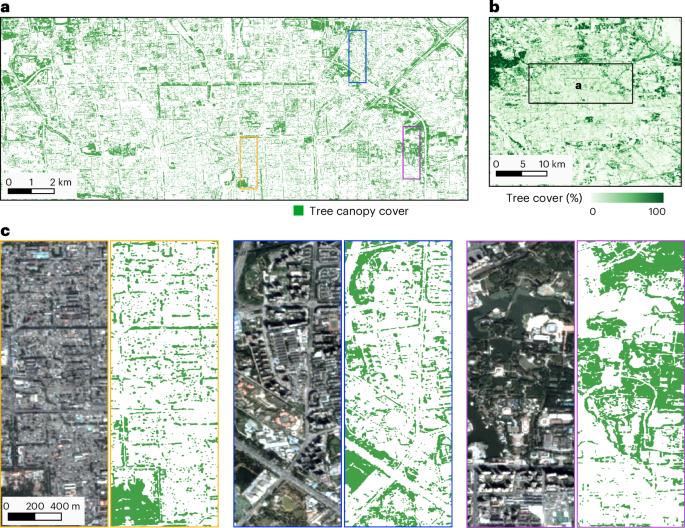A strong but uneven increase in urban tree cover in China over the recent decade
引用次数: 0
Abstract
Trees play a crucial role in urban environments, offering various ecosystem services that contribute to public health and human well-being. China has initiated a range of urban greening policies to increase the number of urban trees, but monitoring urban tree dynamics at a national scale has proven challenging. Here, we used high-resolution nanosatellite images to quantify urban tree cover in all major Chinese cities in 2019 and study changes in tree cover between 2010 and 2019. We show that 11.47% of urban areas were covered by trees in 2019, and 76% of the cities experienced an increase in tree cover compared with 2010. Notably, the increase in tree cover in the mega-cities of Shanghai, Beijing, Shenzhen and Guangzhou (6.64%) was higher than that in other cities analyzed. Tree cover increases also vary between urban land use types, with public service (3.09%) and residential areas (1.79%) having the highest values. The study employed a data-driven approach toward assessing urban tree cover changes, showing clear signs of overall increases that nonetheless do not benefit all cities equally. Trees enrich cities, contributing to urban ecosystems and to the health of urban populations. This study quantifies urban tree coverage in all major Chinese cities, finding that greening efforts are successful but that certain mega-cities are benefiting more.

近十年来中国城市树木覆盖率的强劲但不均衡的增长
树木在城市环境中发挥着至关重要的作用,提供各种生态系统服务,有助于公共健康和人类福祉。中国已经启动了一系列城市绿化政策,以增加城市树木的数量,但在全国范围内监测城市树木的动态已被证明是具有挑战性的。本文利用高分辨率纳米卫星图像量化了2019年中国所有主要城市的城市树木覆盖,并研究了2010 - 2019年中国城市树木覆盖的变化。我们发现,2019年11.47%的城市地区被树木覆盖,76%的城市的树木覆盖率比2010年有所增加。值得注意的是,上海、北京、深圳和广州等特大城市的树木覆盖率增长(6.64%)高于其他分析城市。城市土地利用类型的树木覆盖增加也存在差异,其中公共服务(3.09%)和居民区(1.79%)的增加值最高。该研究采用了一种数据驱动的方法来评估城市树木覆盖的变化,显示出明显的总体增长迹象,但并非所有城市都受益。树木丰富了城市,有助于城市生态系统和城市人口的健康。这项研究量化了中国所有主要城市的城市树木覆盖率,发现绿化工作是成功的,但某些特大城市受益更多。
本文章由计算机程序翻译,如有差异,请以英文原文为准。
求助全文
约1分钟内获得全文
求助全文

 求助内容:
求助内容: 应助结果提醒方式:
应助结果提醒方式:


